
ANGELFREILAUFROLLE 3000-S / 5000-S
FREESPOOL REEL 3000-S / 5000-S
MOULINET À TAMBOUR TOURNANT 3000-S / 5000-S
ANGELFREILAUFROLLE 3000-S / 5000-S
Gebrauchsanweisung
FREESPOOL REEL 3000-S / 5000-S
Instructions for use
MOULINET À TAMBOUR TOURNANT 3000-S / 5000-S
Instructions d’emploi
VRIJLOOPMOLEN 3000-S / 5000-S
Gebruiksaanwijzing
KOŁOWROTEK Z WOLNYM BIEGIEM 3000-S / 5000-S
Instrukcja obsługi
VOLNOBĚŽNÝ RYBÁŘSKÝ NAVIJÁK 3000-S / 5000-S
Návod k obsluze
RYBÁRSKY VOĽNOBEŽNÝ NAVIJAK 3000-S / 5000-S
Návod na obsluhu
I A N 3 06115
A
B
E F
DC
1
1
5
4
2
2
3
4
5
DE/AT/CH
Congratulations!
With your purchase you have decided on
a high-quality product. Get to know the
product before you start to use it.
Carefully read the following
operating instructions.
Usethe product only as described and only
for the given areas of application. Keep
these instructions safe. When passing the
product on to a third party, always make
sure that the documentation is included.
Symbols used
Date of manufacture (month/year):
11/2018
Parts Overview (Fig. A)
1 Free spool lever
2 Knob
3 Anti-Reverse Lock – Prevents the spool
from spinning and twisting
4 Spool with front drag – Adjust your drag
here
5 Brake nut
Free spool system (Fig. B)
Slide the free spool lever 1 forward to ac-
tivate free spooling. If a fish bites it can now
take line off the spool with the bail closed.
The free spooling drag can be adjusted with
the knob 2 without impacting the brake.
Free spooling will automatically engage
when the knob is turned. The bail may also
be closed manually.
The brake (Fig. C)
Large fish are too strong to simply reel in.
Adjust the brake nut 5 until the spool 4
slides with the rod bent about halfway. The
fish can now first make a run and pull line off
the spool, but quickly tires as it has to fight
the resistance from the brake.
Spooling reel with line
Tie the line to the reel using a grinner knot
(Fig. D).
Spool the reel to about 3mm from the lip
(Fig.E).
Using free spool
1. Trolling
When trolling from a boat with bait fish, un-
like artificial bait, you should not set the hook
immediately when the fish bites. It’s rather
advisable to first give the predatory fish a
few seconds to turn and swallow the bait
fish. Set free spooling as light as possible–
once it bites the fish can now easily pull
line off the spool while the fisherman gains
time to grab the rod. Be sure to pop the free
spooling before it completely unwinds, for
example by slightly turning the knob!
2. Bottom fishing (Fig. F)
The rod is on two holders, free spooling is
engaged. When a fish bites the bite indicator
will move upward. The free spool must be
closed before completely unwinding.
In standing water free spooling is fine-tuned
so that the biting fish can pull line off the
spool without the line wafting off the spool or
tangling as with an open bail. When fishing
rivers it must be adjusted according to the
current.
3. Fishing carp
In modern carp fishing the fish will hook to
the heavy lead itself. The bite is actually
the carp’s first method of flight. Unlike other
fishing methods in this case high resistance is
not only beneficial but required. Close free
spooling as far as possible to set the hook
deeper and take the line off the bottom as
soon as possible (risk of snags). However,
be sure the rod is securely seated in the rod
holder to avoid the rod falling into the water
on a bite!
Notes on the guarantee and
service handling
The product was produced with great care
and under constant supervision. You receive
a three-year warranty for this product from
the date of purchase. Please retain your
receipt.
The warranty applies only to material and
workmanship and does not apply to misuse
or improper handling. Your statutory rights,
especially the warranty rights, are not af-
fected by this warranty.
With regard to complaints, please contact
the following service hotline or contact us by
e-mail. Our service employees will advise as
to the subsequent procedure as quickly as
possible. We will be personally available to
discuss the situation with you.
Any repairs under the warranty, statutory
guarantees or through goodwill do not
extend the warranty period. This also applies
to replaced and repaired parts.
Repairs after the warranty are subject to a
charge.
IAN: 306115
Service Great Britain
Tel.: 0800 404 7657
Service Ireland
Tel.: 1890 930 034
(0,08 EUR/Min., (peak))
(0,06 EUR/Min., (off peak))
GB/IE FR/BE
Félicitations !
Vous avez acquis un produit de haute qualité.
Apprenez à connaître le produit avant sa
première utilisation.
Lisez pour cela attentivement
lanotice d’utilisation sui-
vante.
N’utilisez le produit que comme décrit et pour
les zones d’application indiquées. Veuillez
conserver cette notice d’utilisation. Transmet-
tez tous les documents en cas de cession du
produit à une tierce personne.
Symboles utilisés
Date de fabrication (Mois/Année) :
11/2018
Désignation des pièces
(ill. A)
1 Levier de libération
2 Bouton rotatif
3 Verrouillage anti-retour – Evite que la
bobine ne culbute et ne vrille
4 Bobine avec frein avant – Régler ici la
résistance de frein
5 Ecrou du frein
Système de moulinet (ill.B)
Faites glisser le levier de libération 1 vers
l’avant pour actionner le système de moulinet.
Lorsqu‘un poisson morde, il peut tirer sur le fil
de la bobine même si l’étrier est fermé.
La résistance du système de moulinet peut être
réglée en continu avec le bouton rotatif2 ,
cela n’influence pas le réglage du frein. Le
système de moulinet saute automatiquement
lorsque la manivelle est tournée. Il est possible
également si désiré de repousser le levier.
Le frein (ill. C)
Les poissons plus gros ont trop de force pour
faire revenir la manivelle. Régler l’écrou de
frein5 jusqu’à ce que la bobine4 glisse
avec la canne à moitié courbée. Le poisson
peut tout d’abord fuir et tirer le fil de la
bobine mais se fatigue rapidement car il doit
pour cela surmonter la résistance du frein.
Embobinage du fil
Fixez le fil en effectuant un nœud de Grinner
sur la bobine (ill. D).
Remplissez la bobine jusqu’env. 3 mm en-des-
sous du bord (ill. E).
Utilisation du moulinet
1. Pêche à la traîne
Si l’on pêche à la traîne avec des appâts de
poissons depuis le bateau, on ne doit pas se
concentrer en premier lieu sur le fait que le
poisson carnassier morde contrairement aux
appâts artificiels. Il est plutôt recommandé de
donner au poisson tout d’abord quelques se-
condes pour mordre et avaler le poisson d’ap-
pât – lorsqu’il mord le poisson carnassier peut
prendre le fil sans gêne pendant que nous
gagnons du temps pour attraper la canne.
Veiller à ce que le moulinet ne saute pas de
la butée à cause d’une courte vrille de la
manivelle par exemple !
2. Pêche au fond (ill. F)
La canne repose sur deux supports. Le mouli-
net est opérationnel. Lorsqu’un poisson mord,
la flèche monte vers le haut. Le moulinet doit
être fermé avant la butée.
En eau calme, le moulinet est réglé si finement
que le poisson qui mord peut tirer le fil de
la bobine sans que le fil – comme avec les
étriers ouverts – ne flotte de la bobine ou ne
s’emmêle. Dans les fleuves, le réglage doit
être adapté au courant.
3. Pêche à la carpe
Dans la pêche à la carpe moderne, le
poisson s’accroche lui-même au plomb lourd.
La morsure est pour être précise la première
fuite de la carpe accroché. Contrairement
aux autres méthodes de pêche à la ligne,
une grande résistance est ici pas seulement
avantageuse mais est également nécessaire.
Tournez le moulinet pour qu’il soit le plus
dur possible afin de faire pénétrer le crochet
encore plus profondément et décrocher le fil
à temps du fond (risque de rester accroché).
Mais veillez à ce que votre canne reste bien
fixe sur les supports sinon elle tombera dans
l’eau dès qu’un poisson mord !
Mise au rebut
L’emballage et l’article doivent être éliminés
de manière favorable à l’environnement.
Eliminez l’article par l’intermédiaire d’une
entreprise de recyclage autorisée ou via
les services compétents de votre commune.
Veuillez tenir compte des directives actuelles
en vigueur.
Ce produit est recyclable. Il est
soumis à la responsabilité élargie
du fabricant et est collecté séparé-
ment.
Indications concernant la
garantie et le service après-
vente
Le produit a été fabriqué avec le plus grand
soin et sous un contrôle permanent. Vous avez
sur ce produit une garantie de trois ans à
partir de la date d’achat. Conservez le ticket
de caisse.
La garantie est uniquement valable pour les
défauts de matériaux et de fabrication, elle
perd sa validité en cas de maniement incor-
rect ou non conforme. Vos droits légaux, tout
particulièrement les droits relatifs à la garan-
tie, ne sont pas limitées par cette garantie.
En cas d‘éventuelles réclamations, veuillez
vous adresser à la hotline de garantie indi-
quée ci-dessous ou nous contacter par e-mail.
Nos employés du service client vous indique-
ront la marche à suivre le plus rapidement
possible. Nous vous renseignerons personnel-
lement dans tous les cas.
La période de garantie n‘est pas prolongée
par d’éventuelles réparations sous la garantie,
les garanties implicites ou le remboursement.
Ceci s‘applique également aux pièces
remplacées et réparées. Les réparations
nécessaires sont à la charge de l’acheteur à
la fin de la période de garantie.
G
Herzlichen Glückwunsch!
Mit Ihrem Kauf haben Sie sich für einen
hochwertigen Artikel entschieden. Machen
Sie sich vor der ersten Verwendung mit dem
Artikel vertraut.
Lesen Sie hierzu aufmerksam
die nachfolgende Gebrauchs-
anweisung.
Benutzen Sie den Artikel nur wie beschrieben
und für die angegebenen Einsatzbereiche.
Bewahren Sie diese Gebrauchsanweisung
gut auf. Händigen Sie alle Unterlagen bei
Weiter gabe des Artikels an Dritte ebenfalls
mit aus.
Verwendete Symbole
Herstellungsdatum (Monat/Jahr):
11/2018
Teilebezeichnung (Abb. A)
1 Freilaufhebel
2 Drehknopf
3 Rücklaufsperre – Verhindert ein Über-
schlagen und Verdrehen der Rolle
4 Spule mit Frontbremse – Stellen Sie hier
den Bremswiderstand ein
5 Bremsmutter
Freilaufsystem (Abb. B)
Schieben Sie den Freilaufhebel 1 nach
vorn, um den Freilauf einzuschalten. Beim
Biss kann jetzt ein Fisch trotz geschlossenem
Bügel Schnur von der Rolle ziehen.
Der Widerstand des Freilaufs kann über den
Drehknopf 2 stufen los eingestellt werden,
die Bremseinstellung bleibt davon unbe-
einflusst. Der Freilauf springt automatisch
heraus, sobald die Kurbel gedreht wird.
Wahlweise lässt sich der Hebel auch manuell
zurücklegen.
Die Bremse (Abb. C)
Größere Fische sind zu kräftig, um sie
einfach hereinzukurbeln. Verstellen Sie die
Bremsmutter5 , bis die Spule 4 bei etwa
halbgebogener Rute durchrutscht. Der Fisch
kann jetzt zunächst flüchten und Schnur
von der Rolle ziehen, ermüdet aber rasch,
weil er dabei den Widerstand der Bremse
überwinden muss.
Aufspulen der Schnur
Befestigen Sie die Schnur mit einem Grinner-
Knoten an der Spule (Abb. D).
Füllen Sie die Spule bis ca.3mm unter den
Rand (Abb. E).
Einsatz des Freilaufs
1. Schleppfischen
Wird mit Köderfischen vom Boot geschleppt,
sollte der Anhieb im Gegensatz zu Kunst-
ködern nicht sofort beim Biss gesetzt werden.
Vielmehr ist es ratsam, dem Raubfisch zuerst
einige Sekunden Zeit zum Drehen und Schlu-
cken des Köderfisches zu gönnen. Stellen
Sie den Freilauf so leicht wie möglich ein.
Beim Biss kann der Räuber jetzt ungehindert
Schnur nehmen, während wir Zeit gewinnen,
die Rute zu greifen. Achten Sie darauf, dass
der Freilauf vor dem Anschlag herausspringt,
etwa durch eine kurze Kurbelumdrehung!
2. Grundangeln (Abb. F)
Die Rute liegt auf zwei Haltern, der Freilauf
ist eingeschaltet. Beim Biss wandert der
Bissanzeiger nach oben. Vor dem Anschlag
muss der Freilauf geschlossen werden.
Der Freilauf wird im stehenden Wasser so
fein eingestellt, dass der beißende Fisch
Schnur von der Rolle ziehen kann, ohne dass
die Schnur – wie beim offenen Bügel– von
der Rolle weht oder sich verwickelt. Im Fluss
muss die Einstellung an die Strömung ange-
passt werden.
3. Karpfenangeln
Beim modernen Karpfenangeln hakt sich
der Fisch am schweren Blei selbst. Der Biss
ist genau genommen die erste Flucht des
gehakten Karpfens. Im Gegensatz zu allen
anderen Angel methoden ist hier ein großer
Widerstand nicht nur von Vorteil, sondern
sogar notwendig. Drehen Sie den Freilauf so
fest wie möglich zu, um den Haken noch tie-
fer hineinzutreiben und die Schnur rechtzeitig
vom Grund zu lösen (Hängergefahr). Achten
Sie aber auf einen sicheren Halt Ihrer Rute im
Rutenständer, sonst wird die Rute beim Biss
ins Wasser gezogen!
Hinweise zur Garantie und
Serviceabwicklung
Der Artikel wurde mit großer Sorgfalt
und unter ständiger Kontrolle produziert.
Sieerhalten auf diesen Artikel drei Jahre
Garantie ab Kaufdatum. Bitte bewahren Sie
den Kassenbon auf. Die Garantie gilt nur für
Material- und Fabrikationsfehler und entfällt
bei missbräuchlicher oder unsachgemäßer
Behandlung. Ihre gesetzlichen Rechte, insbe-
sondere die Gewährleistungsrechte, werden
durch diese Garantie nicht eingeschränkt.
Bei etwaigen Beanstandungen wenden Sie
sich bitte an die unten stehende Service-
Hotline oder setzen Sie sich per E-Mail mit
uns in Verbindung. Unsere Servicemitarbeiter
werden das weitere Vorgehen schnellstmög-
lich mit Ihnen abstimmen. Wir werden Sie in
jedem Fall persönlich beraten.
Die Garantiezeit wird durch etwaige Re-
paraturen aufgrund der Garantie, gesetz-
licher Gewährleistung oder Kulanz nicht
verlängert. Dies gilt auch für ersetzte und
reparierte Teile. Nach Ablauf der Garantie
anfallende Reparaturen sind kostenpflichtig.
IA N: 30 6115
Service Deutschland
Te l.: 0 80 0 - 5435111
E-Mail: deltasport@lidl.de
Service Österreich
Tel.: 0820 201 222
(0,15EUR/Min.)
E-Mail: deltasport@lidl.at
Service Schweiz
Tel.: 0842 665566
(0,08 CHF/Min., Mobilfunk
max. 0,40CHF/Min.)
E-Mail: deltasport@lidl.ch
I A N 3 0 6115
DELTA-SPORT HANDELSKONTOR GMBH
Wragekamp 6
DE-22397 Hamburg
GERMANY
11/2018
FreeSpool 3000-S: Delta-Sport-Nr.: FR-5671
FreeSpool 5000-S: Delta-Sport-Nr.: FR-5672

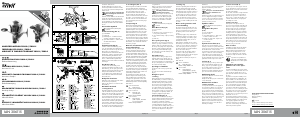


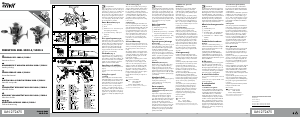
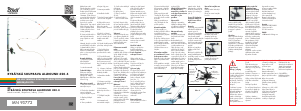
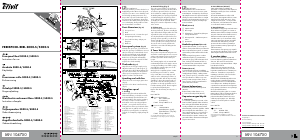
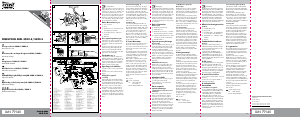
Dołącz do dyskusji na temat tego produktu
Tutaj możesz podzielić się swoją opinią na temat Crivit IAN 306115 Kołowrotek wędkarskie. Jeśli masz pytanie, najpierw dokładnie przeczytaj instrukcję. Zapytanie o instrukcję można złożyć za pomocą naszego formularza kontaktowego.